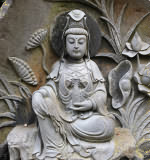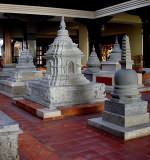Истоки индо-европейских языков: Часть V
Персидский язык и каспийский диалект, курдский язык, восточно-иранский и тохарский языки
Introduction
Hi, Andrés Muni again. The following document has plenty of names: names of languages, regions, countries, etc. I have attempted to translate all those names into English properly to a certain extent, but since my knowledge of English language is limited, I maybe made some mistakes.
If you note some errors, please e-mail me in order to correct the mistake.
In this document, we will go deeper into the development of Iranian languages. Well, let us get down to work.
Persian language and Caspian dialects
Of the current Iranian languages, the major one is the Persian language. It is representative of a great civilization and owns a rich literature. The first documents which were written in this language date from 9th century BC, and they are hardly distinguishable from those written in southern Pahlavi language. Since that time the Persian tongue has undergone just a few changes and it was even adopted by writers who were natives of dialectally different Iranian regions.
Persian language uses the Arabic alphabet, but it adds some diacritical characters. It possesses an entirely Iranian vocabulary, which was enriched by borrowed Arabian words as time went by. During the Middle Ages, Persian language was spread to the East as a common tongue. It was spoken even in India (Delhi's court) and you may find traces of it in Urdu language.
Outside Persia, the Persian language is spoken in a vast region of Afghanistan and Turkestan. As a common tongue, it includes a number of vernacular dialects, some of which appear to be residues of other Iranian tongues. For example: the dialects of Kachan, Nayin, Chiraz and Sivand, in central Persia. The dialect of the Parsees --which is spoken specially in Yezd-- is sometimes erroneously called "Deri". Even though the Parsees in India have their most prosperous communities in Mum'bai (ex-Bombay), they speak in Gujarātī. Finally, within Persia itself, the Persian language competes with Turkish, Arabic, Armenian, Afghan and Balochi languages as well as with the Caspian and Kurdish dialects.
The Caspian dialects are as follows: the major one is known as Mazanderani (this name proceeds from "Mazainya daeva" of Avesta). The Semnani dialect (spoken in Semnan) is closely allied to Mazanderani. There are also two dialects somewhat different: Gilaki (in the region of Rasht) and Talyshi (ranging up to Aras river in Azerbaijan). In turn, in the peninsula of Absheron (near Baku), there is another Caspian dialect known as Tat. The Caspian dialects form a group apart. They are very different from the Persian language and share some common characteristics with the northern Iranian tongue.
Kurdish language
The domain of the Kurdish language is a difficult-to-delimit one. It is spoken by tribes which are partly nomadic. For that reason, it was carried
to the North: to the area near Yerevan and Kars (in Russian Armenia);
to the West: to Cilicia and Syria;
to the East: to central Persia, Khorassan and Afghanistan.
The center of the Kurdish domain is the mountainous region that separates Persia from Turkey. Thus, it comprises mainly the Kurdistan (in Turkish territory).
The Kurdish language is constituted by three dialectal groups:
| Western Kurdish language or Kurmanji | It is spoken in the regions of Diyarbakır, Mardin, Siirt and Julamerk. |
| Eastern Kurdish language | It is spoken in the regions of Sulaymaniyah y Sanandaj. |
| Southern Kurdish language | It is spoken in the region of Kermanshah and in the country of the Bakhtiaris and Lurs. |
In turn, these three groups are formed from rather different tongues. The Kurdish language belongs to western Iranian language, but it shares some common characteristics with the nothern Iranian language. The Kurdish literature is practically an oral one. It consists of fragments of epic, tales and popular chants.
Eastern Iranian language
It is represented by Balochi and Afghan languages as well as the dialects of Pamir. There is no unity among them though.
| 1) Balochi language | It is spoken in the region delimited by the Oman sea, the Ganges river (right up to Dera-Ghazi-Khan), the desert of Rajasthan and the Helmand river, and finally the tableland of Sarhad and Makran. |
| 2) Afghan language or Pushtu |
The geographical limits of this language (Afghanistan) do not coincide with those of its domain, because in some regions of that country the Persian, Balochi, Mongolian, Turkish and Arabic languages are also spoken. In turn, Pushtu is also spoken in some regions of Persia and India (along the Ganges river). |
| 3) Dialects of Pamir | They are spoken in the region of Pamir. |
1) The center of the Balochi's domain is occupied by the Brahuis, who speak in a Dravidian language. Thus, there are two separate dialectal groups in Balochi language: a) Northern Balochi --with a vocabulary mostly influenced by Indian tongues--, and b) Southern Balochi --which is also known as Makrani--.
These two dialectal groups are very different from one another and they are subsequently divided into numerous subdialects.
2) The Afghan language or Pushtu is the tongue of the Afghans, who call themselves "Pustana". Its written literature begins in the 16th century. During the 17th century it experienced a poetical blossoming, which was inspired by the Persian models. It currently owns one of the richest oral literatures, mainly tales and popular chants. There is a common Afghan language that is spoiken everywhere, but there are also local tongues which may be boiled down to two groups of dialects: a) A northern dialectal group --Kabul, Peshawar--, and b) A second dialectal group ranging from the South to the East.
3) In the region of Pamir, numerous Iranian dialects are spoken. These dialects are the survivors of a great and very ancient Iranian expansion. In Central Asia a number of Buddhist text have been found. These texts proceed from both the septentrional valleys of Hindu Kush and the region of Khotan, and they have the particular quality of being written in Iranian language but by using Indian alphabet. In the valleys of Pamir, the groups speaking Iranian language are lost in the middle of towns and villages that speak in Turkish and Indian dialects. These Iranian dialects that nowadays survive in the region of Pamir are commonly known as Galcha. They are constituted by several tongues with shared characteristics: a) Wakhi, Ishkashimi, Shighni and Roshani dialects --arranged at regular intervals along the Pandi river--, b) Sarik dialect --which is spoken in the eastern foothill of Pamir-- and c) Sanglechi and Mindzani dialects --which are spoken in the valleys to the north of Hindu Kush--.
The previous dialects resemble the Caspian ones, and they are probably traces of a central Iranian group that was different from the Persian and Scythian groups as well as from Afghan language.
To the northwest of Pamir, in the valley of Yaghnob river, there is an Iranian dialect which is distinct from those mentioned previously by me. Its name: Yaghnobi. Yaghnobi is a northern Iranian dialect that comes from the Sogdian language. Osetin is another representative tongue of northern Iranian lenguage. Osetin is a vestige of the aggregate of Scythian languages which were predominant in meridional Russia before Scythian people were driven back by the Slavs. Osetin's domain comprises a sector of Caucasus (to the north of Vladicaucasus). There are two variants of it:
| Eastern Osetin or Tagaur |
It is spoken in the valleys of Ardon, Sadon and Giseldon rivers by Alaghiris, Kurtatis and Tagauris. |
| Western Osetin or Digor |
It is spoken in the watershed of Urukh river by Digoris. |
Note that Osetin is the eastern dialect that was used to translate the Holy Bible during the first half of the 19th century.
Tocharian language
Among the Indo-European languages of Asia, there is an important one which forms an independent group. Its name: Tocharian. It belongs to Central Asia. Only a fragmented texts in Tocharian language still survive at present. They have gotten inspiration from the Sanskrit literature (Note that the alphabet which was used in those texts is of Indian origin). They are fragments of documents dealing with medicine and Buddhist religion. They are partly translations of Sanskrit documents. Tocharian was not only a religious and scholar language, but it was also spoken as a living language.
The aforesaid documents reveal the existence of two different dialects which were designated Tocharian A and Tocharian B. Afterward, two particular names --related to the region where they were found-- were assigned to them: a) Turfani: Tocharian language of Turfan, and b) Kushani: Tocharian language of Kushan.
Among the documents in Kushani language, a number of caravan passwords with the name of a king (Suvarnate) written on them were found. That king, according to Chinese testimonies, ruled in the first half of the 7th century. This shows that at that time, Tocharian B was commonly spoken in the region. The exact date in which both of dialects became extinct could not be determined yet.
Concluding remarks
I apologize again for the inevitable mistakes. It was a hard task to write this document in Spanish, let alone in English. I invite once more to e-mail me if you detected an error and really know how to correct it. Next document will deal with the Hellenic and Armenian groups. I hope my task bring bliss and enlightenment to your life. Best wishes.
Further Information
Этот документ был составлен Андресом Муни, одним из двух основателей этого сайта, экспертом в лингвистике.
Для получения дополнительной информации о санскрите, йоге, индийской философии, или если вы просто хотите оставить комментарий, задать вопрос или нашли ошибку, напишите нам: Это наша электронная почта .





























